英语部分否定和全部否定
英语的部分否定与全部否定
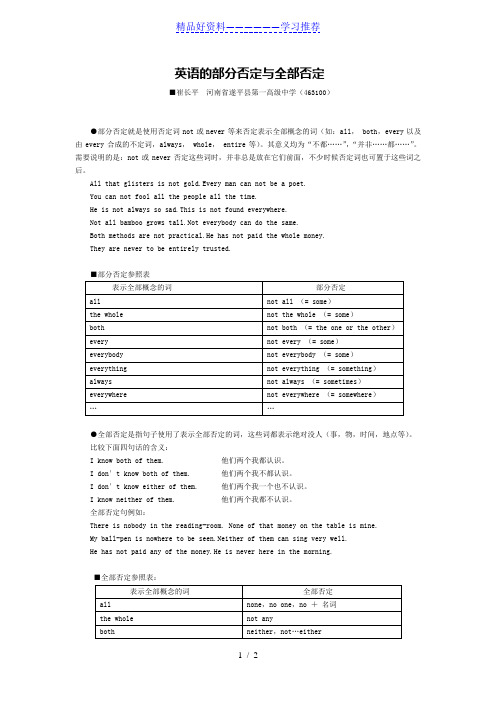
英语的部分否定与全部否定■崔长平河南省遂平县第一高级中学(463100)●部分否定就是使用否定词not或never等来否定表示全部概念的词(如:all, both,every以及由every合成的不定词,always, whole, entire等)。
其意义均为“不都……”,“并非……都……”。
需要说明的是:not或never否定这些词时,并非总是放在它们前面,不少时候否定词也可置于这些词之后。
All that glisters is not gold.Every man can not be a poet.You can not fool all the people all the time.He is not always so sad.This is not found everywhere.Not all bamboo grows tall.Not everybody can do the same.Both methods are not practical.He has not paid the whole money.They are never to be entirely trusted.■部分否定参照表●全部否定是指句子使用了表示全部否定的词,这些词都表示绝对没人(事,物,时间,地点等)。
比较下面四句话的含义:I know both of them. 他们两个我都认识。
I don′t know both of them. 他们两个我不都认识。
I don′t know either of them. 他们两个我一个也不认识。
I know neither of them. 他们两个我都不认识。
全部否定句例如:There is nobody in the reading-room. None of that money on the table is mine.My ball-pen is nowhere to be seen.Neither of them can sing very well.He has not paid any of the money.He is never here in the morning.■全部否定参照表:。
英语中的部分否定与全部否定
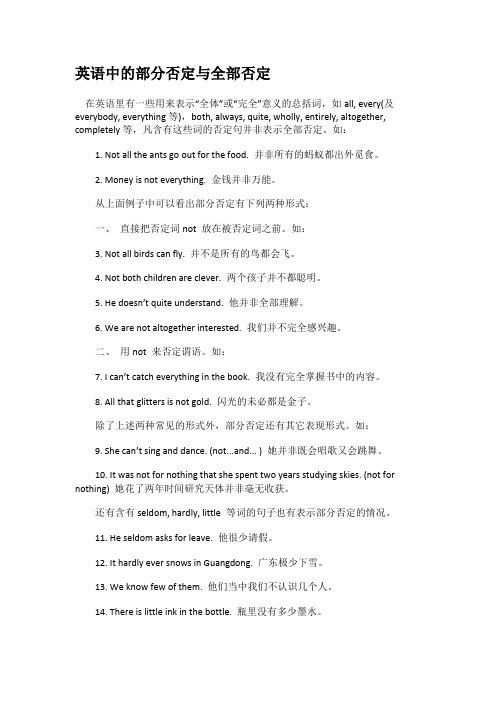
英语中的部分否定与全部否定在英语里有一些用来表示“全体”或“完全”意义的总括词,如all, every(及everybody, everything等),both, always, quite, wholly, entirely, altogether, completely等,凡含有这些词的否定句并非表示全部否定。
如:1. Not all the ants go out for the food. 并非所有的蚂蚁都出外觅食。
2. Money is not everything. 金钱并非万能。
从上面例子中可以看出部分否定有下列两种形式:一、直接把否定词not 放在被否定词之前。
如:3. Not all birds can fly. 并不是所有的鸟都会飞。
4. Not both children are clever. 两个孩子并不都聪明。
5. He doesn’t quite understand. 他并非全部理解。
6. We are not altogether interested. 我们并不完全感兴趣。
二、用not 来否定谓语。
如:7. I can’t catch everything in the book. 我没有完全掌握书中的内容。
8. All that glitters is not gold. 闪光的未必都是金子。
除了上述两种常见的形式外,部分否定还有其它表现形式。
如:9. She can’t sing and dance. (not...and... ) 她并非既会唱歌又会跳舞。
10. It was not for nothing that she spent two years studying skies. (not for nothing) 她花了两年时间研究天体并非毫无收获。
还有含有seldom, hardly, little 等词的句子也有表示部分否定的情况。
11. He seldom asks for leave. 他很少请假。
部分否定与全部否定
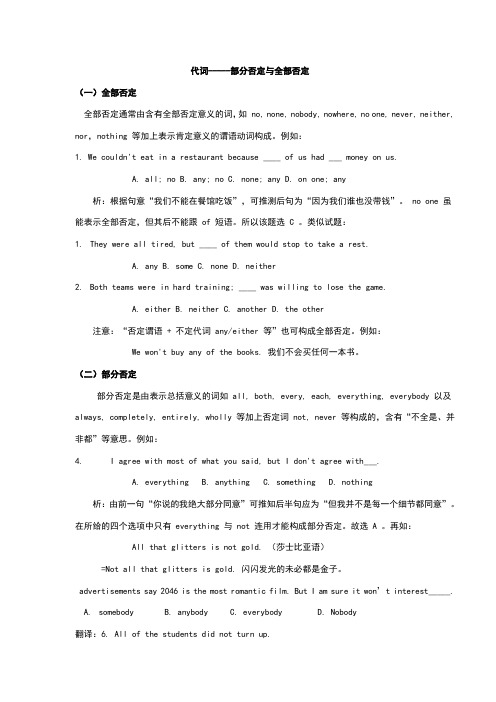
代词-----部分否定与全部否定(一)全部否定全部否定通常由含有全部否定意义的词,如 no, none, nobody, nowhere, no one, never, neither, nor,nothing 等加上表示肯定意义的谓语动词构成。
例如:1. We couldn't eat in a restaurant because ____ of us had ___ money on us.A. all; noB. any; noC. none; anyD. on one; any析:根据句意“我们不能在餐馆吃饭”,可推测后句为“因为我们谁也没带钱”。
no one 虽能表示全部否定,但其后不能跟 of 短语。
所以该题选 C 。
类似试题:1.They were all tired, but ____ of them would stop to take a rest.A. anyB. someC. noneD. neither2.Both teams were in hard training; ____ was willing to lose the game.A. eitherB. neitherC. anotherD. the other注意:“否定谓语 + 不定代词 any/either 等”也可构成全部否定。
例如:We won't buy any of the books. 我们不会买任何一本书。
(二)部分否定部分否定是由表示总括意义的词如 all, both, every, each, everything, everybody 以及always, completely, entirely, wholly 等加上否定词 not, never 等构成的,含有“不全是、并非都”等意思。
例如:4. I agree with most of what you said, but I don't agree with___.A. everythingB. anythingC. somethingD. nothing析:由前一句“你说的我绝大部分同意”可推知后半句应为“但我并不是每一个细节都同意”。
高考英语中的八种否定形式,千万别混淆!

高考英语中的八种否定形式,千万别混淆!完全否定英语中的完全否定可以用not, no, never, none, nobody, nothing, neither...nor, nowhere等表示。
如:1.Nothing is difficult for him. 没什么难得到他。
2.Mary never has beef. 玛丽从来不吃牛肉。
3.Neither answer is correct. 两种答案都不对。
部分否定英语中表示全体意义的代词,形容词或副词。
如:all, both, altogether, always, completely, every day, everyone, everything, everywhere, every, everybody, many, often等与not搭配时,通常表示部分否定,意思是并非都是、不完全是、不是每个都是等。
例如:1.Not everyone was amused by these April Fool s jokes.并不是每个人都觉得这些玩笑有趣。
2.Food likes and dislikes do not always seem related to nutrition.对食物的好恶似乎并不总与营养有关。
比较:Nothing makes him happy.(全部否定)没有哪一件事情让他开心。
Not everything makes him happy.(部分否定)并不是每一件事都让他开心。
None of the students went to visit the science museum last week.(完全否定)上周没有一个学生去参观科技博物馆。
Not all of the students went to visit the science museum last week.(部分否定)上周并不是所有的学生都去参观了科技博物馆。
英语中部分否定与全部否定的用法
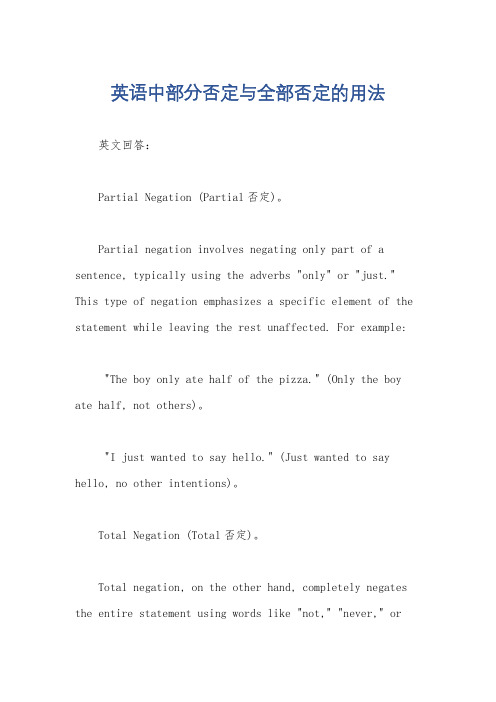
英语中部分否定与全部否定的用法英文回答:Partial Negation (Partial否定)。
Partial negation involves negating only part of a sentence, typically using the adverbs "only" or "just." This type of negation emphasizes a specific element of the statement while leaving the rest unaffected. For example:"The boy only ate half of the pizza." (Only the boy ate half, not others)。
"I just wanted to say hello." (Just wanted to say hello, no other intentions)。
Total Negation (Total否定)。
Total negation, on the other hand, completely negates the entire statement using words like "not," "never," or"no." It expresses a complete absence or lack of something. Examples include:"The boy did not eat the pizza." (He didn't eat any of it)。
"I have never been to Paris." (Not even once)。
英语中的部分否定与全部否定
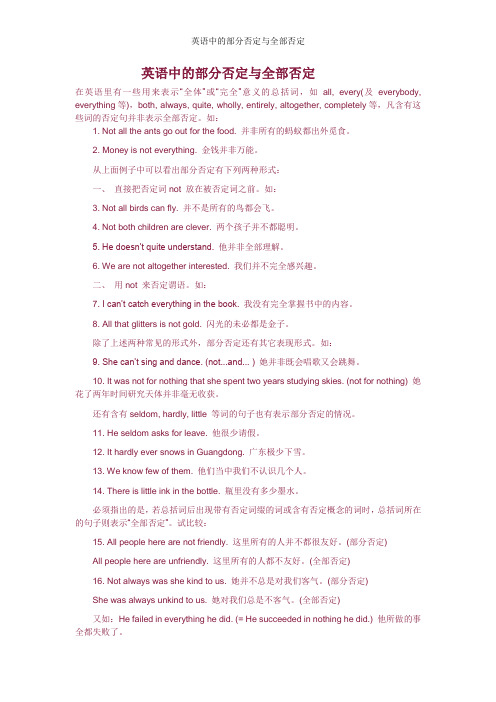
英语中的部分否定与全部否定在英语里有一些用来表示“全体”或“完全”意义的总括词,如all, every(及everybody, everything等),both, always, quite, wholly, entirely, altogether, completely等,凡含有这些词的否定句并非表示全部否定。
如:1. Not all the ants go out for the food. 并非所有的蚂蚁都出外觅食。
2. Money is not everything. 金钱并非万能。
从上面例子中可以看出部分否定有下列两种形式:一、直接把否定词not 放在被否定词之前。
如:3. Not all birds can fly. 并不是所有的鸟都会飞。
4. Not both children are clever. 两个孩子并不都聪明。
5. He doesn’t quite understand. 他并非全部理解。
6. We are not altogether interested. 我们并不完全感兴趣。
二、用not 来否定谓语。
如:7. I can’t catch everything in the book. 我没有完全掌握书中的内容。
8. All that glitters is not gold. 闪光的未必都是金子。
除了上述两种常见的形式外,部分否定还有其它表现形式。
如:9. She can’t sing and dance. (not...and... ) 她并非既会唱歌又会跳舞。
10. It was not for nothing that she spent two years studying skies. (not for nothing) 她花了两年时间研究天体并非毫无收获。
还有含有seldom, hardly, little 等词的句子也有表示部分否定的情况。
11. He seldom asks for leave. 他很少请假。
部分否定与全部否定

部分否定与全部否定让我们先看下面两个句子:( 1 )All my friends do not know English.我的朋友并不是都懂英语。
( 2 )None of my fiends know English.我的朋友没有一个懂英语。
句( 1 )中的all … not相当于“ not all ”,意思是“并非全部”。
这就是所谓的“部分否定”。
此句也可改写为:Not all my friends know English.句( 2 )中的none 是与all not 相对应的全部否定,在英语中涉及部分否定的词语除all外还有the whole, both, everybody, everything, always, everywhere 等。
现将常见的一些词或词组的部分否定与全部否定对照关系举例如下:1. not all (some )和none, no one, no …a. Not all birds can fly.不是所有的鸟都会飞。
(部分否定)没有一只鸟会下棋。
(全部否定)2. not the whole (some )和not anya. He hasn't paid the whole amount.他并未付清全部款项。
(部分否定)b. He hasn't paid any of the money.这笔钱他分文未付。
(全部否定)3. not both (the one or the other )和neither ,not … eithera. I cannot promote either of you.你们两位我不能都提升。
(部分否定)b. I cannot promote either of you.你们两位我都不能提升。
(全部否定)4. not everybody (some people )和nobodya. Not everybody can do the same.并非每个人都能同样这么做。
英语中的八种否定形式,你知道吗
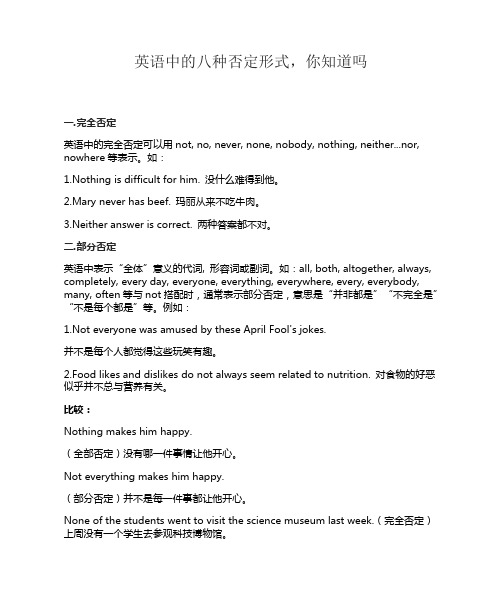
英语中的八种否定形式,你知道吗一.完全否定英语中的完全否定可以用not, no, never, none, nobody, nothing, neither...nor, nowhere等表示。
如:1.Nothing is difficult for him. 没什么难得到他。
2.Mary never has beef. 玛丽从来不吃牛肉。
3.Neither answer is correct. 两种答案都不对。
二.部分否定英语中表示“全体”意义的代词, 形容词或副词。
如:all, both, altogether, always, completely, every day, everyone, everything, everywhere, every, everybody, many, often等与not搭配时,通常表示部分否定,意思是“并非都是”“不完全是”“不是每个都是”等。
例如:1.Not everyone was amused by these April Fool's jokes.并不是每个人都觉得这些玩笑有趣。
2.Food likes and dislikes do not always seem related to nutrition. 对食物的好恶似乎并不总与营养有关。
比较:Nothing makes him happy.(全部否定)没有哪一件事情让他开心。
Not everything makes him happy.(部分否定)并不是每一件事都让他开心。
None of the students went to visit the science museum last week.(完全否定)上周没有一个学生去参观科技博物馆。
否定句
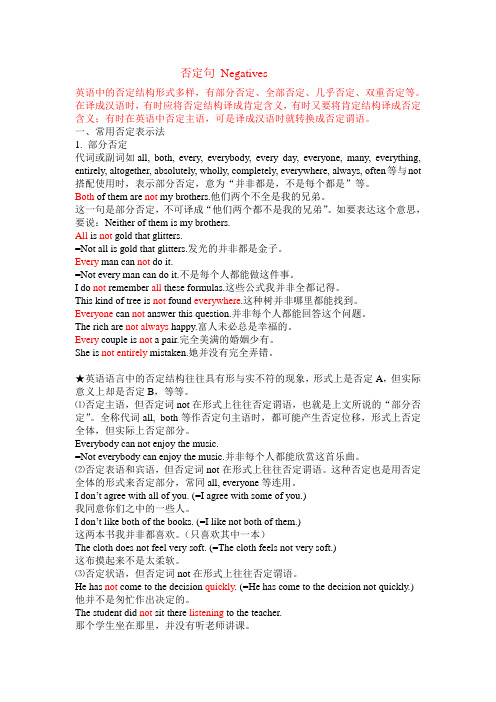
否定句Negatives英语中的否定结构形式多样,有部分否定、全部否定、几乎否定、双重否定等。
在译成汉语时,有时应将否定结构译成肯定含义,有时又要将肯定结构译成否定含义;有时在英语中否定主语,可是译成汉语时就转换成否定谓语。
一、常用否定表示法1. 部分否定代词或副词如all, both, every, everybody, every day, everyone, many, everything, entirely, altogether, absolutely, wholly, completely, everywhere, always, often等与not 搭配使用时,表示部分否定,意为“并非都是,不是每个都是”等。
Both of them are not my brothers.他们两个不全是我的兄弟。
这一句是部分否定,不可译成“他们两个都不是我的兄弟”。
如要表达这个意思,要说:Neither of them is my brothers.All is not gold that glitters.=Not all is gold that glitters.发光的并非都是金子。
Every man can not do it.=Not every man can do it.不是每个人都能做这件事。
I do not remember all these formulas.这些公式我并非全都记得。
This kind of tree is not found everywhere.这种树并非哪里都能找到。
Everyone can not answer this question.并非每个人都能回答这个问题。
The rich are not always happy.富人未必总是幸福的。
Every couple is not a pair.完全美满的婚姻少有。
She is not entirely mistaken.她并没有完全弄错。
英语中的部分否定与全部否定

英语中的部分否定与全部否定在英语里有一些用来表示“全体”或“完全”意义的总括词,如all,every(及everybody, everything等),both, always, quite, wholly, entirely, altogether, completely等,凡含有这些词的否定句并非表示全部否定。
如:1. Not all the ants go out for the food. 并非所有的蚂蚁都出外觅食。
2. Money is not everything. 金钱并非万能。
从上面例子中可以看出部分否定有下列两种形式:一、直接把否定词not 放在被否定词之前。
如:3. Not all birds can fly. 并不是所有的鸟都会飞。
4. Not both children are clever. 两个孩子并不都聪明。
5. He doesn’t quite understand. 他并非全部理解。
6. We are not altogether interested. 我们并不完全感兴趣。
二、用not 来否定谓语。
如:7. I can’t catch everything in the book. 我没有完全掌握书中的内容。
8. All that glitters is not gold. 闪光的未必都是金子。
除了上述两种常见的形式外,部分否定还有其它表现形式。
如:9. She can’t sing and dance. (not...and... ) 她并非既会唱歌又会跳舞。
10. It was not for nothing that she spent two years studying skies. (not for nothing) 她花了两年时间研究天体并非毫无收获。
还有含有seldom, hardly, little 等词的句子也有表示部分否定的情况。
11. He seldom asks for leave. 他很少请假。
英语中的半否定和全否定怎样区分

英语中的半否定和全否定怎样区分在英语里有一些用来表示“全体”或“完全”意义的总括词,如all, every(及everybody, everything等),both, always, quite, wholly, entirely, altogether, completely等,凡含有这些词的否定句并非表示全部否定。
如:1. Not all the ants go out for the food. 并非所有的蚂蚁都出外觅食。
2. Money is not everything. 金钱并非万能。
从上面例子中可以看出部分否定有下列两种形式:一、直接把否定词not 放在被否定词之前。
如:3. Not all birds can fly. 并不是所有的鸟都会飞。
4. Not both children are clever. 两个孩子并不都聪明。
5. He doesn’t quite understand. 他并非全部理解。
6. We are not altogether interested. 我们并不完全感兴趣。
二、用not 来否定谓语。
如:7. I can’t catch eve rything in the book. 我没有完全掌握书中的内容。
8. All that glitters is not gold. 闪光的未必都是金子。
除了上述两种常见的形式外,部分否定还有其它表现形式。
如:9. She can’t sing and dance. (not...and... ) 她并非既会唱歌又会跳舞。
10. It was not for nothing that she spent two years studying skies. (not for nothing) 她花了两年时间研究天体并非毫无收获。
还有含有seldom, hardly, little 等词的句子也有表示部分否定的情况。
部分否定和全部否定

you prefer? —Actually I didn ' t like ______. A.both of them B. either of them C. none of them D. neither of them
Hale Waihona Puke ① I know none of them .
② I like neither of the books .
③ No student goes to the farm on Sunday.
④ No one/ Nobody in our class likes football.
Practice
① We haven't enough books for _______; some of you will have to share.
部分否定和全部否定 期中复习
部分否定
? 在英语中all, both, every, everyone, everything, everybody, everywhere 等与否定 词not, no 连用时,表示的是部分否定,而非 全部否定。
① I don't know all of them. ② I don't like both of the books. ③ Not every student goes to the farm on
Sunday. ④ Not everyone in our class likes football.
全部否定
? 若要表示全部否定,则应用相应得表示部 分否定的否定词。 all –none, both ---neither, every —no, everyone —no one (nobody ), everything —nothing, everywhere — nowhere 等。
英语否定句用法
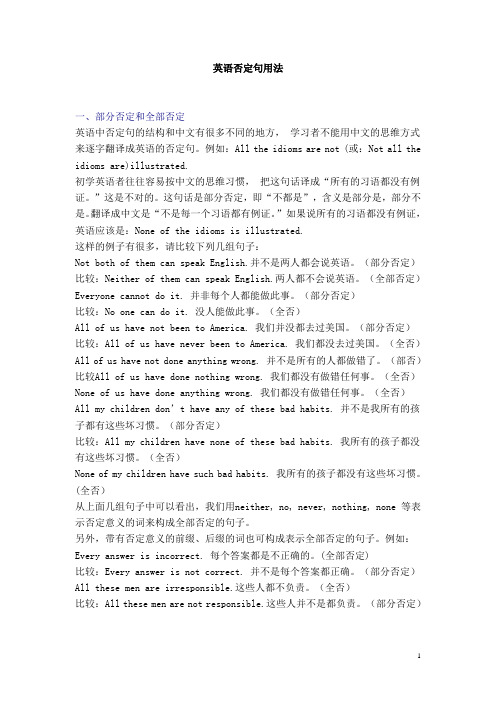
英语否定句用法一、部分否定和全部否定英语中否定句的结构和中文有很多不同的地方,学习者不能用中文的思维方式来逐字翻译成英语的否定句。
例如:All the idioms are not (或:Not all the idioms are)illustrated.初学英语者往往容易按中文的思维习惯,把这句话译成“所有的习语都没有例证。
”这是不对的。
这句话是部分否定,即“不都是”,含义是部分是,部分不是。
翻译成中文是“不是每一个习语都有例证。
”如果说所有的习语都没有例证,英语应该是:None of the idioms is illustrated.这样的例子有很多,请比较下列几组句子:Not both of them can speak English.并不是两人都会说英语。
(部分否定)比较:Neither of them can speak English.两人都不会说英语。
(全部否定)Everyone cannot do it. 并非每个人都能做此事。
(部分否定)比较:No one can do it. 没人能做此事。
(全否)All of us have not been to America. 我们并没都去过美国。
(部分否定)比较:All of us have never been to America. 我们都没去过美国。
(全否)All of us have not done anything wrong. 并不是所有的人都做错了。
(部否)比较All of us have done nothing wrong. 我们都没有做错任何事。
(全否)None of us have done anything wrong. 我们都没有做错任何事。
(全否)All my childre n don’t have any of these bad habits. 并不是我所有的孩子都有这些坏习惯。
(部分否定)比较:All my children have none of these bad habits. 我所有的孩子都没有这些坏习惯。
八种否定形式
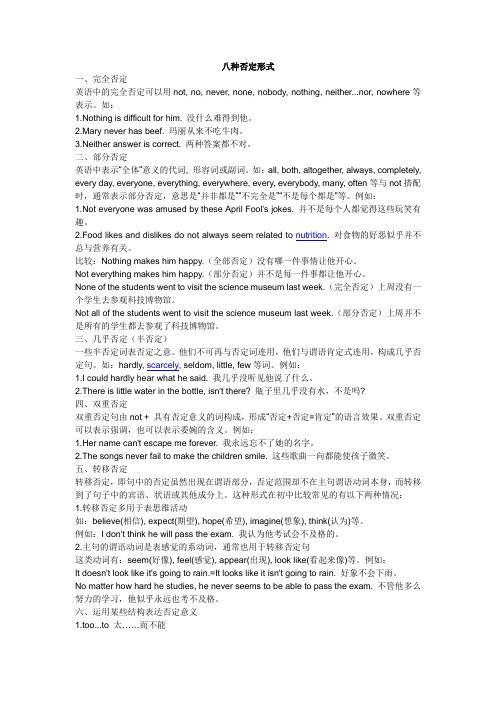
八种否定形式一、完全否定英语中的完全否定可以用not, no, never, none, nobody, nothing, neither...nor, nowhere等表示。
如:1.Nothing is difficult for him. 没什么难得到他。
2.Mary never has beef. 玛丽从来不吃牛肉。
3.Neither answer is correct. 两种答案都不对。
二、部分否定英语中表示“全体”意义的代词, 形容词或副词。
如:all, both, altogether, always, completely, every day, everyone, everything, everywhere, every, everybody, many, often等与not搭配时,通常表示部分否定,意思是“并非都是”“不完全是”“不是每个都是”等。
例如:1.Not everyone was amused by these April Fool's jokes. 并不是每个人都觉得这些玩笑有趣。
2.Food likes and dislikes do not always seem related to nutrition. 对食物的好恶似乎并不总与营养有关。
比较:Nothing makes him happy.(全部否定)没有哪一件事情让他开心。
Not everything makes him happy.(部分否定)并不是每一件事都让他开心。
None of the students went to visit the science museum last week.(完全否定)上周没有一个学生去参观科技博物馆。
Not all of the students went to visit the science museum last week.(部分否定)上周并不是所有的学生都去参观了科技博物馆。
部分否定和全部否定的讲解
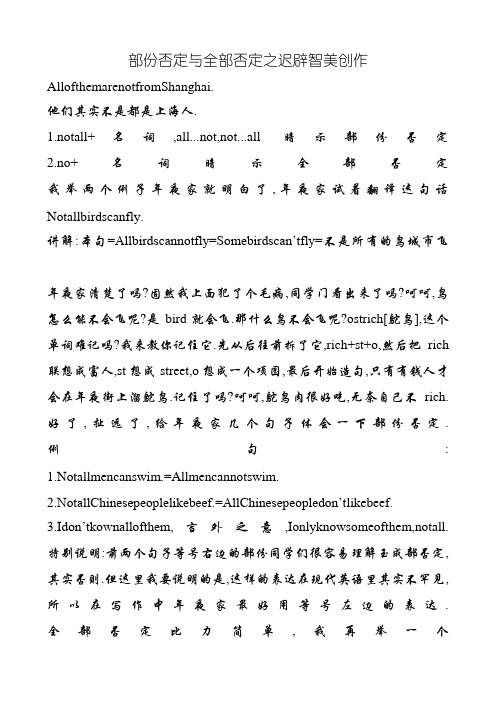
部份否定与全部否定之迟辟智美创作AllofthemarenotfromShanghai.他们其实不是都是上海人.1.notall+名词,all...not,not...all暗示部份否定2.no+名词暗示全部否定我举两个例子年夜家就明白了,年夜家试着翻译这句话Notallbirdscanfly.讲解:本句=Allbirdscannotfly=Somebirdscan’tfly=不是所有的鸟城市飞年夜家清楚了吗?固然我上面犯了个毛病,同学门看出来了吗?呵呵,鸟怎么能不会飞呢?是bird就会飞.那什么鸟不会飞呢?ostrich[鸵鸟],这个单词难记吗?我来教你记住它.先从后往前拆了它,rich+st+o,然后把rich 联想成富人,st想成street,o想成一个项圈,最后开始造句,只有有钱人才会在年夜街上溜鸵鸟.记住了吗?呵呵,鸵鸟肉很好吃,无奈自己不rich.好了,扯远了,给年夜家几个句子体会一下部份否定. 例句:1.Notallmencanswim.=Allmencannotswim.2.NotallChinesepeoplelikebeef.=AllChinesepeopledon’t likebeef.3.Idon’tkownallofthem,言外之意,Ionlyknowsomeofthem,notall. 特别说明:前两个句子等号右边的部份同学们很容易理解玉成部否定,其实否则.但这里我要说明的是,这样的表达在现代英语里其实不罕见,所以在写作中年夜家最好用等号左边的表达. 全部否定比力简单,我再举一个Nomencanfly.[这个不是病句,是真理,没人反对吧,自己水平有限,太难的句子怕写错了]中学英语教材中,英语的否定句是一个语法的重点,同时又是一个难点.在教学中发现有很多学生对英语句子的全部否定和部份否定翻译时不够准确,年夜部份学生是依照字面翻译.英汉互译时,遣词禁绝,不注重英汉语言的习惯表达法.这样既影响了学生对文章中的语句理解的准确性,又影响了学生运用英语的能力.笔者就中学英语的否定句类型浅谈全部否定和部份否定句的英汉互译.英语中的否定句,就其否定的范围来说,可分为全部否定(CompleteNegation)和部份否定(PartialNegation).暗示全部否按时,经常使用含“绝无”意义的否定词(如:none/no/neither/nobody/nothing/never/nowhere等)加上肯定式谓语.例如:Noneofthean-swersarecorrect.全部谜底都不正确.Neitherofthefilmsisinteresting.这两部片子都无趣味.Nothingintheworldisdifficultforonewhosetshismindtoit.世上无难事,只怕有心人.InevercametovisitShanghaiinthepast.过去我从未来观赏上海.Thisumbrellawasnowheretobefound.这把伞哪里也找不到了.NobodyelsebutIwent.除我以外,谁也没去.Nopains,nogains.不劳则无获.暗示部份否按时,除用含“部份”意义的代词、副词(如:some,somebody,something,somewhere,some-what等)加上否定谓语(如:Someworkersaren′texpe-rienced.)以外,还有其它特殊的表达法.①“all,every,both…+not…”结构.此结构在英语中使用最广泛.其意思是部份否定,与中文“不是全部”、“不是每个都”、“不是两者都”相当.如果否定词not放置这些词之前(如:notall…,notevery…,notboth…),就更加能突出其部份否定的意思.这种新颖的用法尤其在美国英语中用得普遍.例如:Allisnotgoldthatglitters.=Notallthatglittersisgold.发光的其实不都是金子.Idon′tknowbothofthem.=Iknownotbothofthem.他们俩我不都认识.Everybodywouldn′tlikeit.=Noteverybodywouldlikeit.其实不是每个人城市喜欢它.Allthenewsisnottrue.这些消息其实不都是真实的.Idon′trememberallthesewords.我其实不全都记得这些话.Hedoesn′tknoweverythingaboutit.=Heknowsnoteverythingaboutit.对此他其实不完全了解情况.②“many,always,much,everywhere,wholly,entire-ly,altogether+not”结构.例如:Theyhaven′tgotmuchnewsyet.他们还没有获得很多消息.Therearenotmanypeoplewhocansingthissong.能够唱这首歌的人其实未几.Hewasnotentirelyhappy.他其实不感到十分高兴.Suchabookisnotfoundeverywhere.这类书其实不是处处都有.Thisisnotalwaysgoodinstructivefilm.这部片子其实不是有很好教育意义的片子.从某种意义上讲:notalways=sometimes;notev-erywhere=somewhere;notwholly=insomedegree;notaltogether=somewhat.③…not…+adverbial(attributive,complement)+and+adverbial(attributive?熏complement)”结构.在这个结构中,“and”在否定句中,若连接两个状语或定语或表语时,与之搭配的“not”有时只暗示部份否定,即只否定“and”后面的部份.例如:ThatTVplayisnotinterestingandinstructive.那部电视剧虽有趣味,但没有教育意义.Shedidn′texplainthistextcorrectlyorclearly.她对这篇课文解释得很正确,但不够清楚.上述两例中的“and”,如果换用“or”,就酿成了全部否定了.ThatTVplayisnotinterestingorinstructive.那部电视剧既没有趣味,也无教育意义.Shedid′texplainthistextcorrectlyorclearly.她对这篇课文既没有解释得很正确,也没有解释得很清楚.④“…not…+…aswellas…”结构在这个结构中,not只否定它前面的部份,暗示部份肯定.而aswellas后面的部份则暗示“肯定”.例如:Hedoesn′tdanceaswellassing.他唱歌,但不跳舞.Thechildisn′tlivelyaswellashealthy.这个孩子健康,但不活泼.若把上述例句中not去失落,酿成肯定句,就即是notonly…butalso.例如:Hedancesaswellassings.他跳舞唱歌同样优美.Thechildislivelyaswellashealthy.这个孩子既健康又活泼.总之,英语中的否定表达形式很丰富,本文仅仅起着举一反三、举一反三和抛砖引玉的目的.请看下面这个句子:Thisisourfirstlesson,soIdon'tknowallyournames.这一句的后半部份该怎样理解呢?究竟是“你们的名字我全不知道”还是“你们的名字我不全知道”呢?很多学生对此感到茫然.这就涉及到英语中的部份否定和全部否定.上面这个看似全部否定的句子,其实暗示的是部份否定.在英语中all,both,every,everyone,everything等与否定词not连用时,暗示的是部份否定,而非全部否定.例如:Idon'tknowallofthem.我其实不全认识他们.Idon'tlikebothofthebooks.这两本书我其实不都喜欢. NoteverystudentgoestothefarmonSundays.其实不是每个学生星期天都去农场.Noteveryoneinourclasslikesfootball.在我们班其实不是每个人都喜欢足球.若要暗示全部否定,则应用相应的暗示全部否定的否定词.如:all→none(一个人也没有、没有任何工具),both→neither(两个都不),every→no,everyone→noone(nobody),everything→nothing 等.上述四个例句要暗示全部否定应分别为:Iknownoneofthem.他们我都不认识.Ilikeneitherofthebooks.这两本书我都不喜欢. NostudentgoestothefarmonSundays.星期天没有学生去农场.Noone/Nobodyinourclasslikesfootball.我们班没有人喜欢足球.★部份否定:当not与all,every,both等连用时,暗示部份否定.not可以放在这些词前,也可以放在句中.[例句]Notallofthemknowtheanswer.=Allofthemdon’tknowtheanswer.=Someofthemknowtheanswer,andtheothersdon’tknowtheanswer.其实不是他们所有的人都知道谜底.Notbothsentencesarewrong.=Bothsentencesarenotwrong.=Oneofthetwosentencesiswrongandtheotheriscorrect.其实不是两个句子都错了.★全部否定:用相应的暗示全部否定的否定词,如:none,noone,no,neither等.[例句]Noneofthemknow(s)theanswer.他们中没有人知道谜底.Neitherofthesentencesis/arewrong.那两个句子都不错.[小试]试把下列句子译成汉语.1.Allbirdshavewings,butnotallbirdscanfly.2.Everystudentcannotpasstheexam.Key:1.所有的鸟都有同党,但其实不是所有的鸟城市飞.2.其实不是所有的学生都可以通过这次测试.3.两扇窗户都没开.请看下面这个句子:Thisisourfirstlesson,soIdon'tknowallyournames.这一句的后半部份该怎样理解呢?究竟是“你们的名字我全不知道”还是“你们的名字我不全知道”呢?很多学生对此感到茫然.这就涉及到英语中的部份否定和全部否定.上面这个看似全部否定的句子,其实暗示的是部份否定.在英语中all,both,every,everyone,everything等与否定词not连用时,暗示的是部份否定,而非全部否定.例如:Idon'tknowallofthem.我其实不全认识他们.Idon'tlikebothofthebooks.这两本书我其实不都喜欢. NoteverystudentgoestothefarmonSundays.其实不是每个学生星期天都去农场.Noteveryoneinourclasslikesfootball.在我们班其实不是每个人都喜欢足球.若要暗示全部否定,则应用相应的暗示全部否定的否定词.如:all→no ne(一个人也没有、没有任何工具),both→neither(两个都不),every→no,everyone→noone(nobody),everything→nothing 等.上述四个例句要暗示全部否定应分别为:Iknownoneofthem.他们我都不认识.Ilikeneitherofthebooks.这两本书我都不喜欢. NostudentgoestothefarmonSundays.星期天没有学生去农场.Noone/Nobodyinourclasslikesfootball.我们班没有人喜欢足球.部份否定是高中阶段重要的语法之一,对它的正确理解和分析有助于我们对文章的理解,而且可以提高解题的准确性.在高一上册的教材中就屡次呈现过含部份否定的句子.如在Unit7中有这样的句子:Perhapsthisisnotalwaystrue,but...句意为:这话也许不总是正确,但……在Unit12中还有:...thatnotallofthemweresafe.意为:……但它们其实不都是平安的.下面就结合例子来简要分析部份否定的要点及用法:在英语里有一些用来暗示“全体”或“完全”意义的总括词,如all,every(及everybody,everything等),both,always,quite,wholly,entirely,altogether,completely等,凡含有这些词的否定句其实不是暗示全部否定.如:1.Notalltheantsgooutforthefood.其实不是所有的蚂蚁都出外觅食.2.Moneyisnoteverything.金钱其实不是万能.从上面例子中可以看出部份否定有下列两种形式:一、直接把否定词not放在被否定词之前.如:3.Notallbirdscanfly.其实不是所有的鸟城市飞.4.Notbothchildrenareclever.两个孩子其实不都聪慧.5.Hedoesn’tquiteunderstand.他其实不是全部理解.6.Wearenotaltogetherinterested.我们其实不完全感兴趣.二、用not来否定谓语.如:7.Ican’tcatcheverythinginthebook.我没有完全掌握书中的内容.8.Allthatglittersisnotgold.闪光的未必都是金子.除上述两种罕见的形式外,部份否定还有其它暗示形式.如:9.Shecan’tsinganddance.(not...and...)她其实不是既会唱歌又会跳舞.10.Itwasnotfornothingthatshespenttwoyearsstudyingskies.(notfornothing)她花了两年时间研究天体其实不是毫无收获.还有含有seldom,hardly,little等词的句子也有暗示部份否定的情况.11.Heseldomasksforleave.他很少请假.12.IthardlyeversnowsinGuangdong.广东极少下雪.13.Weknowfewofthem.他们傍边我们不认识几个人.14.Thereislittleinkinthebottle.瓶里没有几多墨水.必需指出的是,若总括词后呈现带有否定词缀的词或含有否定概念的词时,总括词所在的句子则暗示“全部否定”.试比力:15.Allpeopleherearenotfriendly.这里所有的人其实不都很友好.(部份否定)Allpeoplehereareunfriendly.这里所有的人都不友好.(全部否定)16.Notalwayswasshekindtous.她其实不总是对我们客气.(部份否定) Shewasalwaysunkindtous.她对我们总是不客气.(全部否定)又如:Hefailedineverythinghedid.(=Hesucceededinnothinghedid.)他所做的事全都失败了.总之,只有通过多做多练才华识别出部份否定和全部否定的分歧含义,以便对句子和文章能有更好的理解.楼层: 1[思路分析]分析如下[解题过程]英语中的部份否定(即不完全否定)有如下一些暗示方法:一、 all 的否定式:not all…(或:all…not)暗示\"其实不是都……\"、\"不是所有的都……\"例如:Not all men can be masters. (= All men cannot be masters.) 其实不是人人都能当头头.Not all bamboo grows tall. 其实不是所有的竹子城市长很高.二、 both 的否定式:not…both (或:both… not) \"其实不是两个……都……\" 例如:I don\'t want both the books. 我不是两本书都要.Both (the) windows are not open. 两扇窗子其实不都开着.三、 every…的否定式:\"不是每……都……\" 例如:Not every book is educative. (或:Every book is not educative.) 不是每本书都有教育意义的.Not everyone likes this book. 其实不是人人都喜欢这本书.This flower is not seen everywhere. 这花其实不是随处可见的.四、 always的否定式:\"其实不是总是(其实不是一直)……\" 例如:He is not always so sad. 他其实不是一直都这样哀思.五、 entirely, altogether, completely 和quite 的否定式:\"不完全……\",\"其实不是完全……\" 例如:The businessman is never to be entirely trusted. 不成以完全信任商人. He felt not altogether satisfied. 他其实不完全满意.I don\'t agree completely. 我其实不完全同意.What he did was not quite proper. 他做的不十分妥当.六、 all the time 的否定式:\"其实不是一直……\"、\"未必老是……\" 例如:A foolish man doesn\'t make a mistake all the time. 笨人未必老是犯毛病.七、 not…and…的否定式,被否定的往往是and后面的那一部份. 例如:He did not speak clearly and correctly. 他讲得清楚但不正确.This film is not interesting and instructive. 这部片子有趣但无教育意义. She cannot sing and dance. 她会唱歌但不会跳舞.如果将and 换成or,not 对其后面的两部份就全盘否定了.He did not speak clearly or correctly. 他讲的既不清楚也不正确.如要对上述的all, both, every, always, 以及entirely, altogether, completely, quite 和 all the time 等词作完全否定,那就分别要用与之相对应的全否定词,如no, none, neither, no one, never, not (never)… at all 等.例如:All of them can do it.--- None of them can do it.Both are good.---Neither is good.Everybody likes it. ---Nobody likes it.He is always late. --- He is never late.We don\'t trust them entirely. --- We never trust them at all.He was here all the time. --- He was never here.楼层: 1[思路分析]分析如下[解题过程]英语中的部份否定(即不完全否定)有如下一些暗示方法:一、 all 的否定式:not all…(或:all…not)暗示\"其实不是都……\"、\"不是所有的都……\"例如:Not all men can be masters. (= All men cannot be masters.) 其实不是人人都能当头头.Not all bamboo grows tall. 其实不是所有的竹子城市长很高.二、 both 的否定式:not…both (或:both… not) \"其实不是两个……都……\" 例如:I don\'t want both the books. 我不是两本书都要.Both (the) windows are not open. 两扇窗子其实不都开着.三、 every…的否定式:\"不是每……都……\" 例如:Not every book is educative. (或:Every book is not educative.) 不是每本书都有教育意义的.Not everyone likes this book. 其实不是人人都喜欢这本书.This flower is not seen everywhere. 这花其实不是随处可见的.四、 always的否定式:\"其实不是总是(其实不是一直)……\" 例如:He is not always so sad. 他其实不是一直都这样哀思.五、 entirely, altogether, completely 和quite 的否定式:\"不完全……\",\"其实不是完全……\" 例如:The businessman is never to be entirely trusted. 不成以完全信任商人. He felt not altogether satisfied. 他其实不完全满意.I don\'t agree completely. 我其实不完全同意.What he did was not quite proper. 他做的不十分妥当.六、 all the time 的否定式:\"其实不是一直……\"、\"未必老是……\" 例如:A foolish man doesn\'t make a mistake all the time. 笨人未必老是犯毛病.七、 not…and…的否定式,被否定的往往是and后面的那一部份. 例如:He did not speak clearly and correctly. 他讲得清楚但不正确.This film is not interesting and instructive. 这部片子有趣但无教育意义. She cannot sing and dance. 她会唱歌但不会跳舞.如果将and 换成or,not 对其后面的两部份就全盘否定了.He did not speak clearly or correctly. 他讲的既不清楚也不正确.如要对上述的all, both, every, always, 以及entirely, altogether, completely, quite 和 all the time 等词作完全否定,那就分别要用与之相对应的全否定词,如no, none, neither, no one, never, not (never)… at all 等.例如:All of them can do it.--- None of them can do it.Both are good.---Neither is good.Everybody likes it. ---Nobody likes it.He is always late. --- He is never late.We don\'t trust them entirely. --- We never trust them at all.He was here all the time. --- He was never here.请看下面这个句子:This is our first lesson, so I don't know all your names.这一句的后半部份该怎样理解呢?究竟是“你们的名字我全不知道”还是“你们的名字我不全知道”呢?很多学生对此感到茫然.这就涉及到英语中的部份否定和全部否定.上面这个看似全部否定的句子,其实暗示的是部份否定.[1]Not独自使用,暗示全部否定,可是在英语中 all , both,every, everyone, everything 等与否定词 not 连用时,暗示的是部份否定,而非全部否定.例如:I don't know all of them. 我其实不全认识他们.I don't like both of the books. 这两本书我其实不都喜欢.Not every student goes to the farm on Sundays. 其实不是每个学生星期天都去农场.Not everyone in our class likes football. 在我们班其实不是每个人都喜欢足球.[2] 若要暗示全部否定,则应用相应的暗示全部否定的否定词.如: all → none (一个人也没有、没有任何工具), both → neither (两个都不), every → no, everyone → no one(nobody), everything →nothing 等.上述四个例句要暗示全部否定应分别为:I know none of them. 他们我都不认识.I like neither of the books. 这两本书我都不喜欢.No student goes to the farm on Sundays. 星期天没有学生去农场.No one/ Nobody in our class likes football. 我们班没有人喜欢足球.。
- 1、下载文档前请自行甄别文档内容的完整性,平台不提供额外的编辑、内容补充、找答案等附加服务。
- 2、"仅部分预览"的文档,不可在线预览部分如存在完整性等问题,可反馈申请退款(可完整预览的文档不适用该条件!)。
- 3、如文档侵犯您的权益,请联系客服反馈,我们会尽快为您处理(人工客服工作时间:9:00-18:30)。
关于部分否定和全部否定
1.not all+名词,all...not,not...all表示部分否定
2.no+名词表示全部否定
Not all birds can fly.
讲解:本句=All birds can not fly=Some birds can’t fly=不是所有的鸟都
会飞
那么所有的鸟都不会飞如何表达?
No birds can fly.=Birds can’t fly.----全部否定
大家清楚了吗?当然我上面犯了个错误,同学门看出来了吗?呵呵,鸟怎么能不会
飞呢?是bird就会飞.那什么鸟不会飞呢?ostrich[鸵鸟],这个单词难记吗?我来
教你记住它.先从后往前拆了它,rich+st+o,然后把rich联想成富人,st想成street,o想成一个项圈,最后开始造句,只有有钱人才会在大街上溜鸵鸟.记住
了吗?呵呵,鸵鸟肉很好吃,无奈本人不rich.好了,扯远了,给大家几个句子体会
一下部分否定.
例句:
1.Not all men can swim.=All men can not swim.
2.Not all Chinese people like beef.=All Chinese people don’t like be ef.
3.I don’t kown all of them,言外之意,I only know some of them,not all. 特别说明:前两个句子等号右边的部分同学们很容易理解成全部否定,其实不然.
但这里我要说明的是,这样的表达在现代英语里并不常见,所以在写作中大家最
好用等号左边的表达.
全部否定比较简单,我再举一个
No men can fly.[这个不是病句,是真理,没人反对吧,本人水平有限,太难的句
子怕写错了]
中学英语教材中,英语的否定句是一个语法的重点,同时又是一个难点。
在教学
中发现有不少学生对英语句子的全部否定和部分否定翻译时不够准确,大部分学
生是按照字面翻译。
英汉互译时,遣词不准,不注重英汉语言的习惯表达法。
这
样既影响了学生对文章中的语句理解的准确性,又影响了学生运用英语的能力。
笔者就中学英语的否定句类型浅谈全部否定和部分否定句的英汉互译。
英语中的否定句,就其否定的范围来说,可分为全部否定(complete negation)和部分否定(partial negation)。
表示全部否定时,常用含“绝无”
意义的否定词(如:none/no/neither/nobody/nothing/never/nowhere等)加上肯定式谓语。
例如:None of the answers are correct.全部答案都不正确。
Neither of the films is interesting.
这两部电影都无趣味。
Nothing in the world is difficult for one who sets his mind to it.
世上无难事,只怕有心人。
I never came to visit Shanghai in the past.
过去我从未来参观上海。
This umbrella was nowhere to be found.
这把伞哪里也找不到了。
Nobody else but I went.
除我以外,谁也没去。
No pains , no gains.
不劳则无获。
表示部分否定时,除用含“部分”意义的代词、副词(如: some, somebody, something , somewhere, some-what等)加上否定谓语(如:Some workers aren’t experienced.)以外,还有其它特殊的表达法。
①“all, every, both…+not…”结构。
此结构在英语中使用最广泛。
其意思是部分否定,与中文“不是全部”、“不是每个都”、“不是两者都”相当。
如果否定词not放置这些词之前(如:not all…,not every…,not both…),就更加能突出其部分否定的意思。
这种新颖的用法尤其在美国英语中用得普遍。
例如:
All is not gold that glitters. = Not all that glitters is gold.
发光的并不都是金子。
I don’t know both of them.=I know not both of them.
他们俩我不都认识。
Everybody wouldn’t like it.=Not everybody would like it.
并不是每个人都会喜欢它。
All the news is not true.
这些消息并不都是真实的。
I don’t remember all these words.
我并不全都记得这些话。
He doesn’t know everything about it. = He knows not everything about it.
对此他并不完全了解情况。
②“many,always,much,everywhere, wholly, entirely, altogether+ not,”结构。
例如:They haven’t got much news yet.
他们还没有得到很多消息。
There are not many people who can sing this song.
能够唱这首歌的人并不多。
He was not entirely happy.
他并不感到十分高兴。
Such a book is not found everywhere.
这类书并非到处都有。
This is not always good instructive film.
这部电影并不是有很好教育意义的电影。
从某种意义上讲:not always= sometimes; not everywhere=somewhere; not wholly= in some degree; not altogether=somewhat.
③…not…+adverbial (attributive, complement)+and+adverbial (attributive, complement )”结构。
在这个结构中,“and”在否定句中,若连接两个状语或定语或表语时,与之搭配的“not”有时只表示部分否定,即只否定“and”后面的部分。
例如:
That TV play is not interesting and instructive.
那部电视剧虽有趣味,但没有教育意义。
She didn’t explain this text correctly and clearly.
她对这篇课文解释得很正确,但不够清楚。
上述两例中的“and”,如果换用“or”,就变成了全部否定了。
That TV play is not interesting or instructive.
那部电视剧既没有趣味,也无教育意义。
She didn’t explain this text correctly or clearly.
她对这篇课文既没有解释得很正确,也没有解释得很清楚。
④“…not…+…as well as…”结构
在这个结构中,not只否定它前面的部分,表示部分肯定。
而as well as后面的部分则表示“肯定”。
例如:
He doesn’t dance as well as sing.
他唱歌,但不跳舞。
The child isn’t lively as well as healthy.
这个孩子健康,但不活泼。
若把上述例句中not去掉,变成肯定句,就等于not only …but also.
例如:He dances as well as sings. 他跳舞唱歌同样优美。
The child is lively as well as healthy.
这个孩子既健康又活泼。
总之,英语中的否定表达形式很丰富,本文仅仅起着举一反三、触类旁通和抛砖引玉的目的。
